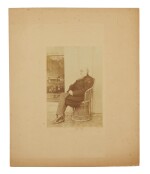Age of Wonder
Age of Wonder

(Darwin, Charles) | An exceptional group of photographic portraits, one of which signed
Lot Closed
December 9, 08:35 PM GMT
Estimate
5,000 - 7,000 USD
Lot Details
Description
(Darwin, Charles)
A group of five photographs, ca. 1863-1878
Maull and Polyblank [photographer]. Stuttgart: Buchner, [printed ca. 1863]. Albumen print (148 x 118 mm) portrait mounted on thick paper, printed caption at foot; faded. — Edwards, Ernest [photographer]. London: London Stereoscopic & Photographic Company, [1867]. Albumen print (90 x 63 mm), vignette bust portrait on carte-de-visite mount, "Stereoscopic Co. Copyright" printed in green at foot, verso with green printed advertisement for the London Stereoscopic & Photographic Company; "Darwin" and "Mr Darwin" in pencil to the mount on recto and verso respectively. — Lock and Whitfield [photographer]. [London: Sampson Low, 1878]. Oval Woodbury-type (approx. 115 x 92 mm) on original printed mount with decorative border; light foxing to mount. — Darwin, Leonard [photographer]. [np, ca. 1874-1878]. Woodbury type (117 x 90 mm) portrait mounted on thick card, inscribed ("yours very faithfully | Ch. Darwin") below the portrait; light spotting to mount. — Leonard, Darwin [photographer]. [Chatham: Royal School of Military Engineering, 1878]. Albumen print (192 x 132 mm) portrait, blindstamped "Photo School Chatham SME," mounted on large heavy card, "Charles Darwin | done ... at Down by his son Leonard" in pencil on verso of mount; print with a closed tear to left margin and some mild creases.
An exceptional group of photographic portraits, including two accomplished by his son, one of which signed by Darwin himself.
The present Maull and Polyblank portrait is one of the earliest obtainable photographs of the scientist; the photographers operated a a studio in London and made at least four different exposures of Darwin between 1853 and 1857 (see lot 1018). October 1862 Darwin had become sufficiently famous that Maull and Polyblank asked, through Charles’s brother Erasmus, for permission to reproduce and sell one of its images of Darwin. Darwin authority Janet Browne observes that the photograph in question was this portrait, in which Darwin wears brightly checked trousers, and she further notes that it is believed to have been made in the late 1850s (Browne, “Looking at Darwin,” Isis, v. 100, 2009).
Darwin, who admired photography greatly, encouraged his sons William and Leonard to pursue the hobby; indeed, Leonard went on to teach chemistry and photography at the Royal School of Military Engineering in Chatham, where at least one of the present portraits was printed by him. The first of the present portraits by Leonard Darwin was taken in 1874. In that year, Darwin had commissioned a cartes-de-visite, but he also "asked his son, Leonard, to produce a more private image," this being the present portrait ("Darwin's Photographic Portraits"). "This image shows Leonard’s increasing photography skills—the depth of tone, posing and detailed focus on Darwin’s countenance in the photograph remind a viewer of the earlier portrait made by Julia Margaret Cameron [see lot 1030]" (ibid.). The photo also served "as a memento for both Darwin and for Leonard. Leonard was soon to depart on his long journey to New Zealand where he would attempt—and ultimately fail—to take photographs of Venus passing over the disc of the Sun" (ibid.). The second photograph, now one of Leonard's best-known photographs of his father, shows Darwin seated in a wicker chair on the veranda of his home in Kent, overlooking the garden—notably, it bears the blindstamp from the photography school at the Royal School of Military Engineering: "Photo School Chatham SME."
The earliest portrait in the present group, taken by Ernest Edwards, was Darwin's first carte-de-visite. Thus the present group traces the long arc of the naturalist's fondness for the medium; "Darwin was a photography enthusiast. This is evident not only in his use of photography for the study of Expression and Emotions in Man and Animal, but can be witnessed in his many photographic portraits and in the extensive portrait correspondence that Darwin undertook throughout his lifetime. His close friend and botanist Joseph Dalton Hooker would come to call Darwin’s epistolary exchange of photographic images as his 'carte correspondence'" (ibid.). Further, portraits of the naturalist were indispensable tools in promoting his work and thereby greatly increased his celebrity.
A wonderful and desirable group of portraits, in a medium Darwin held most dear.
REFERENCE:
"Darwin's Photographic Portraits," Darwin Correspondence Project
